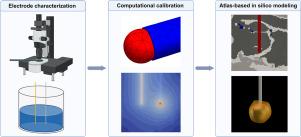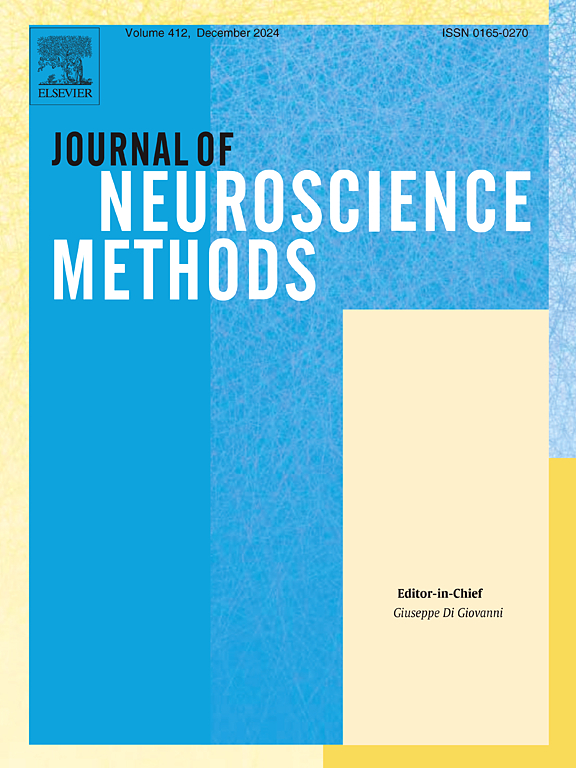Improving computational models of deep brain stimulation through experimental calibration
IF 2.7
4区 医学
Q2 BIOCHEMICAL RESEARCH METHODS
引用次数: 0
Abstract
Background:
Deep brain stimulation has become a well-established clinical tool to treat movement disorders. Nevertheless, the knowledge of processes initiated by the stimulation remains limited. To address this knowledge gap, computational models are developed to gain deeper insight. However, their predictive power remains constrained by model uncertainties and a lack of validation and calibration.
New method:
Exemplified with rodent microelectrodes, we present a workflow for validating electrode model geometry using microscopy and impedance spectroscopy in vitro before implantation. We address uncertainties in the tissue distribution and dielectric properties and outline a concept for calibrating the computational model based on in vivo impedance spectroscopy measurements.
Results:
The standard deviation of the volume of tissue activated across the 18 characterized electrodes was approximately 32.93%, underscoring the importance of electrode characterization. Thus, the workflow significantly enhances the model predictions’ credibility of neural activation exemplified in a rodent model.
Comparison with existing methods:
Computational models are frequently employed without validation or calibration, relying instead on manufacturers’ specifications. Our approach provides an accessible method to obtain a validated and calibrated electrode geometry, which significantly enhances the reliability of the computational model that relies on this electrode.
Conclusion:
By reducing the uncertainties of the model, the accuracy in predicting neural activation is increased. The entire workflow is realized in open-source software, making it adaptable for other use cases, such as deep brain stimulation in humans. Additionally, the framework allows for the integration of further experiments, enabling live updates and refinements to computational models.

通过实验校准改进脑深部刺激的计算模型。
背景:深部脑刺激已成为治疗运动障碍的成熟临床工具。然而,人们对刺激过程的了解仍然有限。为了填补这一知识空白,人们开发了计算模型以获得更深入的了解。然而,这些模型的预测能力仍然受到模型不确定性以及缺乏验证和校准的限制:新方法:以啮齿类动物微电极为例,我们介绍了一种在植入前利用显微镜和阻抗谱在体外验证电极模型几何形状的工作流程。我们讨论了组织分布和介电特性的不确定性,并概述了根据体内阻抗谱测量结果校准计算模型的概念:结果:18 个表征电极上被激活的组织体积的标准偏差约为 32.93%,凸显了电极表征的重要性。因此,该工作流程大大提高了以啮齿动物模型为例的神经激活模型预测的可信度:与现有方法的比较:计算模型通常未经验证或校准,而是依赖于制造商的规格。我们的方法提供了一种获得经过验证和校准的电极几何形状的简便方法,从而大大提高了依赖该电极的计算模型的可靠性:结论:通过减少模型的不确定性,提高了预测神经激活的准确性。整个工作流程是在开源软件中实现的,因此可适用于其他用例,如人类深部脑刺激。此外,该框架还可以整合更多实验,实现计算模型的实时更新和完善。
本文章由计算机程序翻译,如有差异,请以英文原文为准。
求助全文
约1分钟内获得全文
求助全文
来源期刊

Journal of Neuroscience Methods
医学-神经科学
CiteScore
7.10
自引率
3.30%
发文量
226
审稿时长
52 days
期刊介绍:
The Journal of Neuroscience Methods publishes papers that describe new methods that are specifically for neuroscience research conducted in invertebrates, vertebrates or in man. Major methodological improvements or important refinements of established neuroscience methods are also considered for publication. The Journal''s Scope includes all aspects of contemporary neuroscience research, including anatomical, behavioural, biochemical, cellular, computational, molecular, invasive and non-invasive imaging, optogenetic, and physiological research investigations.
 求助内容:
求助内容: 应助结果提醒方式:
应助结果提醒方式:


